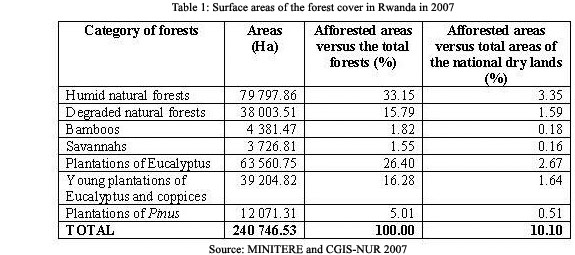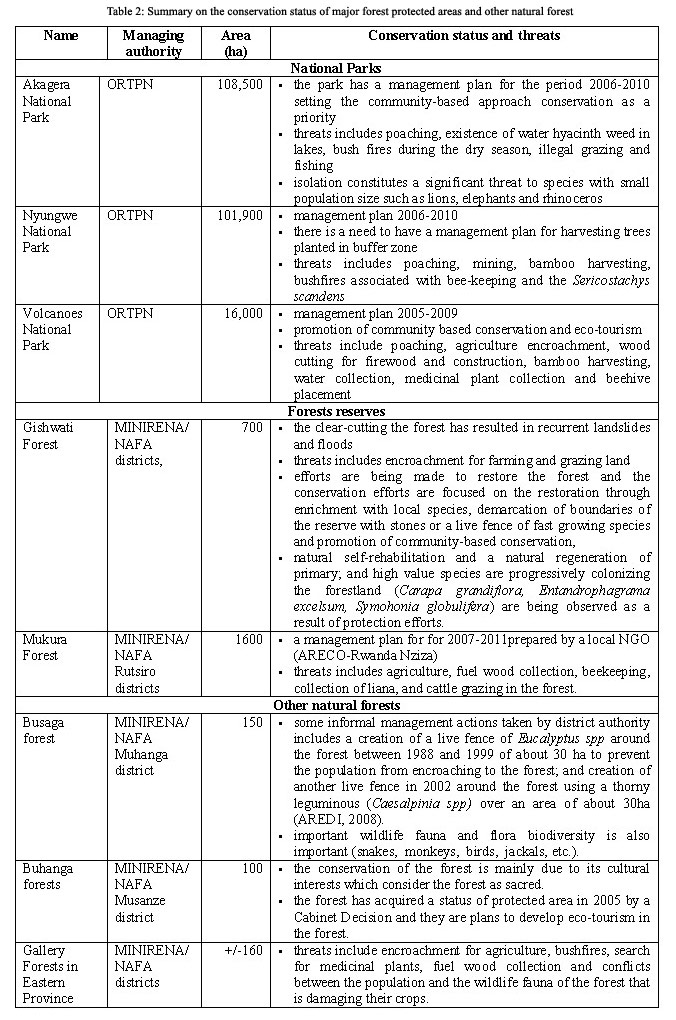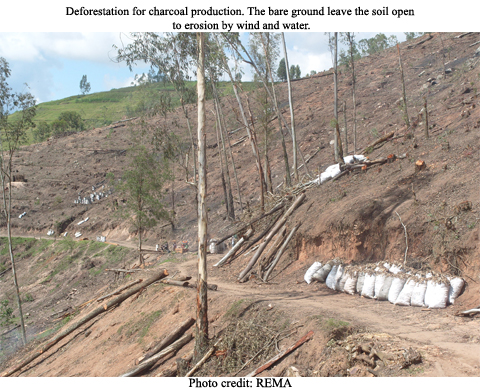|
|
 |
| |
Home > Chapter VI
|
|
Chap VI. Forest and protected areas
|
Current Status of Forestry Resources in Rwanda
|
Rwanda forests and woodlands can be classified into four categories: the natural forests of the Congo Nile Ridge comprised with Nyungwe national park Gishwati, and Mukura; the natural forests of the Volcanoes national park; the natural forests in the savannah and gallery-forest of the Akagera national park and remnants of gallery-forests and savannahs of Bugesera, Gisaka and Umutara; and forest plantations dominated by exotic species (Eucalyptus sp, Pinus sp, Grevillea robusta) and trees scattered on farmlands (agroforestry) and along anti-erosion ditches.
According to a recent mapping inventory, carried out for forests with a surface of 0.5 hectares or higher and with coverage of more than 20 per cent, the forests of the country were estimated at 240,746 ha in 2007. This translates to approximately 10 per cent of the surface of the national dry lands (23,835 km2) (MINITERE and CGIS-NUR 2007). However forest resources in Rwanda include also small woodlots and agro-forestry resources.
Table 1 shows the forest classification in Rwanda, based on the national inventory of forest in Rwanda. This classification shows that humid natural forests constitute the majority of the forest cover in Rwanda (33 per cent), followed by Eucalyptus plantations and degraded natural forests at 26 and 15.7 per cent respectively (MINITERE and CGIS-NUR 2007.

Forest cover
Statistics from the Forest department show that forests were estimated to cover 659,000 ha in 1960 (ROR 2004). This reflects a loss of approximately 64 per cent of forests in between 1960 and 2007, which is more than 1.3 per cent per year. The rapid increase in population is increasing pressure on forests in terms of encroachment and deforestation. Figure 1 shows the change in forest cover between 1988 and 2005.

Protected areas
According to the Convention on Biological Diversity, a protected area is defined as a portion of land, aquatic or sea environment which is geographically delimited, dedicated especially to the protection and the preservation of biological diversity and its natural and cultural resources; hence this geographically area must be legally indicated, regulated and be managed by effective, legal means or others. This definition shows that a protected area must be defined by a legal instrument indicating its limits and have to be managed in an effective manner, which means that somebody or an identified entity is responsible for the management of the area.
According to this definition of protected areas, Rwanda has four types of protected areas which includes national parks (Akagera, Nyungwe and Volcanoes National Park); forest reserves (Gishwati, Iwawa Island and Mukura forest reserves); forests of cultural importance (Buhanga forest); and wetlands of global importance (Rugezi-Bulera-Ruhondo wetland complex). Besides those forests with a legal status of protected areas, there are other forests of cultural importance (Busaga forest in Muhanga district) and other remnant natural forests which are more or less protected by law. In fact the current law on forests prohibits human activities in natural forests. Table 2 provides a summary of the status of major forest protected areas and other natural forests in Rwanda.

|
Opportunities from the forest sector
|
Forests ecosystems provide goods and services such as wood for fuel and construction, water catchment protection, water purification, tourism, non-timber forest products such as medicinal plants, honey and materials for handicrafts.
The national economy
At present, the contribution of the forestry sector to the national economy remains unknown and existing statistics from past years underestimate the contribution of the forestry sector to the national GDP. However, in 1991 the National Commission on Agriculture reported that despite the importance of forest plantations, their contribution to the GDP as recorded in the national accounting system was only 1.9 per cent in 1987 (CAN 1991). In the same vein, the Food Security Strategy and Action Plan of 1997 (MINAGRI 1998) points out that the total contribution of agriculture to the GDP was in the order of 36.6 per cent of which silviculture represented only 0.6 per cent.
Energy
Wood remains the main source of domestic energy for more than 90 per cent of Rwandans. In 1997, fuel wood consumption was estimated at 7.1 million m3 of wood and approximately 5 per cent of this volume was consumed by the small scale industry. Charcoal is usually used in towns and its annual production was estimated at 46,000 tonnes, 80 per cent of which were sold in Kigali (MINAGRI 1998).

Agriculture
Forests indirectly support agriculture through the provision of ecological services. The current deficit of wood in the country is affecting agricultural production. The degradation of soil fertility is partly the consequence of fuel wood shortage in rural areas leading farmers to use crop residues as fuel instead of as organic manure. Studies have pointed out that this practice takes 1.7 ha of organic manure per hectare per year. Losses of fertility resulting from such practices at national level are equivalent to 40,000 tonnes of fertilizers and 33,000 of lime (CAN 1991).
Wood supply
Wood products are used for construction and furniture, among others. There are a number of exotic species available on the local market. The most used include Eucalyptus (45 per cent), Grevillea and Cypress. Imported wood species include Libuyu, Muvula and Markhamia. They are commonly used for furniture and originate mainly from the eastern part of the Democratic Republic of Congo.
The government is conscious that forests for timber need to be sustainably utilised. There are thus restrictions on access to both natural and plantation forests. Even though exploitation of natural forests is forbidden, clandestine activities take place in the form of skimming off of tree species of high commercial value. Species endangered by this form of exploitation are among others, Podocarpus usambarensis, Entandrophragma excelsum and Carapa grandiflora. In 2003, utilization of poles in construction works was totally prohibited in towns to limit exploitation of wood in young forest plantations.
Non-timber forest products
Non-wood forest products are products of biological origin other than wood derived from forests, other wooded lands and trees outside forests. In Rwanda, they are commonly found in the following categories: plants used in traditional human and veterinary medicine, fodder, honey and melliferous plants, fruits, tree seeds, essential oils, handicraft material, mushrooms, ornamental plants, game and fish and ecotourism. The literature shows a list of 59 woody plants used in traditional human medicine and a list of 39 woody plants used in traditional veterinary medicine as well as related diseases in both cases (Mbarubukeye and Niang 1996 in Murekezi 1999).
Beekeeping is another non-timber forest product with potential for growth especially in light of Rwanda’s climate and quality biotopes (natural forests, forest plantations). However there is still scope for development. Research indicates that about 27 melliferous plants have been identified in Nyungwe natural forest (Murekezi 1999). Local beekeepers are thought to be the main cause of the bush fires that rage during the dry season.
Tourism
The tourism sector, which is based on visits to protected areas, has been experiencing good performance since 2002. The Volcanoes National Park is the flagship of Rwandan tourism. This is due to the gorillas which are a major tourism draw, attracting more than 16,000 tourists in 2007. At about US $ 500 each to join organized treks, this makes gorilla tourism one of Rwanda’s largest foreign exchange earners. In 2007, earnings from tourism were estimated at US $42 million (ORTPN pers. Comm. 2008).
Tourism
There are opportunities for the forest sector to access funds under the Clean Development Mechanism (CDM) of the Kyoto protocol for carbon trading. However, there is a need to develop the national capacity and to have a clear strategy to harness these opportunities.
|
Threats to harnessing the opportunities provided by forests
|
Though the forest sector offers many opportunities for national economic growth, it has some challenges which need to be overcome to allow Rwanda to tap into these opportunities. The main threats to forests are mainly governance issues, inadequate legal framework and population pressures that result in encroachment and deforestation for settlement, agriculture and grazing land. These activities are likely to impact on forest ecosystem services such as timber provision, fuel wood, regulation of water flow, climate moderation, soil erosion control and fertility.
Governance and the legal framework
Governance of the forest sector has gone through deep crisis with regards to consequences of the war and the genocide. For instance the death and exile of forest professionals and end of all development projects due to the withdrawal of donors had great impact on the sector. Currently there is a general shortage of human resources in terms of competence and number. This situation is more acute than that during the post-independence period. It is expected that the newly created National Forest Authority will strengthen the forest sector.
Supervision of forests is an area that also needs attention. This is especially for the smaller natural forests which are left to the responsibility of already understaffed local authorities, making them vulnerable to encroachment and degradation. It is thus essential that forest management plans or conservation strategies be developed.
There is need for the legal framework to be updated. The forestry law of 1988 is obsolete as it has been overtaken many of the in-country reforms including administrative reform, decentralisation, and the new administrative appellation. There is also need for better overall enforcement of the law.
Encroachment and human activities
Forest encroachment through various human activities are a threat to Rwandan forests. These activities include illegal logging, charcoal production, and bushfires. A national forest inventory in 2007 identified illegal tree cutting (78.3 per cent), charcoal making (4.9 per cent), livestock grazing (2.5 per cent), farming activities (1.9 per cent), bushfires (1.9 per cent), stem debarking (0.6 per cent), mining (0.5 per cent) and beekeeping (0.4 per cent) as the main threats (MINITERE-ISAR 2007).
Forest encroachment is not a new phenomenon. Most occurred in the years that followed independence in 1962, and during the war and the post-war period (1990-1994 and 1995-1996). Some of these are highlighted below:
- In Nyungwe, aerial photographs showed that the forest has experienced an annual average decrease of 750 ha (1 per cent) due to encroachment for agricultural activities between 1958 and 1972 (Muderevu 1974 in Combe 1977). Figure 2 highlights this forest loss. Major deforestation also took place inside the forest through illegal tree felling as well as skimming of precious tree species which led to impoverishment of the forest almost beyond recovery, following cutting of seed trees required for natural regeneration of those species.
- The Volcanoes National Park has been constantly under threat due to pressure from the farming population due to the fertile volcanic soils in its immediate vicinity. The population density here is the highest of the country. It has also been subject to repeated degazetting by the administration without any legal supporting document. In 1958, 700 ha were cleared to settle the population and between 1969 and 1973, 1,050 ha were converted into agricultural lands to grow pyrethrum (ORTPN 2004).
- In 1997, the Government of Rwanda decided to reduce the Akagera National Park to an area of 108,500 ha or approximately a third of its original area to settle returnees in the aftermath of the war and genocide (ORTPN 2005).
- The Gishwati forest which covered an area of 28,000 ha in 1960 has experienced encroachment for agriculture and pasture lands from the 1980s and for settlement of returnees after 1994. The forests cover currently 700 hectares.
- Mukura forest reserve with an area of about 2,100 ha in 1990, the area of the Mukura forest reserve was progressively reduced to 1,600 ha in 2006 (Munanura et. al. 2006) due to encroachment for agriculture influenced by the installation of a refugee camp in its immediate vicinity.
- It is estimated that during the war, approximately 15,000 ha of forest plantations were completely destroyed and 35,000 ha damaged (MINAGRI, 1998).


Charcoal making
One of the most obvious benefits of forests and woodlands is the provision of energy for heating and cooking in the form of charcoal. Charcoal making uses traditional kilns, which are common because of the low capital required. But they are not efficient and result in severe degradation of forest resources.
The demand for charcoal in urban areas is contributing to the pressures on forests. Charcoal making to supply Kigali has resulted in the disappearance of the shrubby savannahs and gallery-forests in Bugesera. Over 50,000 ha of woody savannas were registered in 1983, dropping to less than 10,000 ha by 1988 (MINAGRI 1988). A field visit conducted by REMA and the Office for Tourism and National Parks (ORTPN) to assess the status of the buffer zone of Nyungwe National Park showed cases of charcoal making in the buffer zone combined with clear tree cutting of the forests.

Other threats to forests
- In Nyungwe, between 1996 and 2003, forest fires destroyed the equivalent of 12,800ha, or approximately 13 per cent of the total area of the forest (ORTPN 2005). Bushfires are also frequently reported in Akagera National Park in dry seasons.
- Mining activities have been recorded in Nyungwe National Park and Gishwati reserve forest and lead to forest destruction.
- Poaching in Nyungwe resulted in extermination of some big mammals - the buffalo and the elephant. According to the literature, the disappearance of large ungulates appears to have upset Nyungwe’s ecological balance. Nyungwe’s elephant population preferred a certain vine (Sericostachys scandens). Now without the elephants, the vines have grown to the extent that they are actually threatening to strangle standing trees. The absence of large ungulates also appears to have hampered forest regeneration in burned areas. Because there are no grazing animals to stem the proliferation of ferns and grass that appear after a fire, they remain to hamper seed dispersal and germination (Chemonics International 2003).
- The introduction of exotic species (eucalyptus and pines) planted in buffer zones or near natural forests are threatening these natural forests.
- In Nyungwe and Volcanoes National park, the illegal harvesting of bamboos for handicraft and construction is becoming a threat to these forests.
|
Strategies to harness opportunities from the forest sector
|
Institutional strengthening
Analysis of the forestry sector shows some weaknesses vis-à-vis institutional capacity. There is need for institutional development at the central administration level - the ministry and the National Forest Authority (NAFA) and at the local level - district and sector. Provision of adequate resources and qualified staff to NAFA, districts and sectors is of paramount importance to ensure sustainable management of forest resources.
In line with this, it will be necessary to improve coordination mechanisms for different actors in the forestry sector. These will include the ministries, authorities, research institutions and non-governmental organizations. Information flow will also have to be improved. Forestry extension at national level, research and documentation of best practice are among some of the strategies that can be used.
The development of human capacity in forestry is an area that has been identified for attention. It involves the education of foresters at technical and professional levels to address the needs of the public and private sectors. In this regards, the National University of Rwanda has started a master’s degree in agro-forestry. There are also other capacity building programmes being implemented through regional and international cooperation.
Promotion of agroforestry
There are efforts to promote the use of improved technologies in agroforestry. In the context of land scarcity, efforts are being made to develop high performing species that integrate better with crops. Agroforestry techniques are among the solutions that can quickly restore the national landscape which, at present shows the tendency for desertification. It may also be necessary to carry out an inventory of available wood resources in the agroforestry system in order to better plan activities of this specific sub sector.
Conversion of old forest plantations
The Rwandese forest landscape is dominated by Eucalyptus plantations which in the long run have greatly contributed to the reduction of fuel wood and service wood deficit. The great majority of plantations of this species were created before independence and are presently in poor condition due to soil degradation and poor management. There is need to convert these plantations and replace them with selected species matching respective ecological zones and types of soils. Some species for consideration include: Acacia mearnsii, Acacia melanoxylon and some species of Eucalyptus like Eucalyptus saligna, E. maideni, E. microcorys and E. grandis.
Protect and conserve small natural forests
In order to save the remnant of this heritage, the ministry in charge of forestry with its partners in environment (REMA, ORTPN, districts and donors) should intervene to carry out an inventory to locate all those forests and develop a management plan to identifying priority actions to be implemented for their conservation.
|
Conclusions
|
Though often underestimated forest resources play an important role in the national economic growth and need to be given necessary attention. The lack of understanding of the impact of population growth on the forests resources has led to severe deforestation accompanied with a host of environmental problems in different parts of the country.
Efforts to restore the degraded forests are on-going and results are encouraging. In this regards, out of the 30 districts, 15 have already prepared their District Forest Management Plans with funds from the African Development Bank, the Embassy of the Netherlands, Switzerland and FAO. Other districts are in various states of completion.
The Government of Rwanda has set a target of increasing the national forest cover from the present 10 per cent to 30 per cent of the national territory by the year 2020. In order to reach this target, there is a need to combine efforts to increase the number of existing protected forests and to add to the number of tree plantations.
|
References
|
- CAN (1991). Rapport Préliminaire le sous-secteur forestier et le développement des ressources halieutiques. Volume Vi. Commission National de l’Agriculture (CAN), Kigali.
- Chemonics International Inc (2003). Rwanda Environmental Threats and Opportunities Assessment. Task Order No. 818 under the Biodiversity & Sustainable Forestry (BIOFOR) IQC USAID Contract No. LAG-I-00-99-00014-00. Also available on: http://www.encapafrica.org/documents/biofor/Rwanda_2003.pdf
- Combe J., (1977). Guide des principales essences de la forêt de montagne du Rwanda. Publ. Projet Pilote Forestier (PPF) Kibuye.
- MINAGRI (1988). Plan d’orentations pour la suavegarde des savanes de l’Est du Rwanda. Ministère de l’Agriculture, de l’Elevage, de l’Environnement et du Développement Rural. (MINAGRI), Kigali.
- MINAGRI (1998). Stratégie et Plan d’action pour la sécurité alimentaire. Ministère de l’Agriculture, de l’Elevage, de l’Environnement et du Développement Rural. (MINAGRI), Kigali.
- MINITERE and CGIS-NUR (2007). Final report on the Mapping of Rwandese forests, Volume 1. The Ministry of Lands, Environment, Forests, Water and Natural Resources (MINITERE) and The Geographic Information Systems & Remote Sensing Research and Training Center of the National University of Rwanda (CGIS – NUR)
- MINITERE-ISAR (2007). Rapport d’inventaire des ressources ligneuses au Rwanda. Volume 2, Ministère des Terres, de l’Environnement, des Forêts, de l’Eau et des Mines (MINITERE) and the National Agricultural Research Institute (ISAR), Kigali.
- Munanura I., Mulindahabi F., Barakabuye N. and Mukakamali (2006). Report of Biodiversity Survey of Mukura Forest. ARECO Rwanda Nziza and Wildlife Conservation Society (WCS and ARECO Rwanda Nziza), Kigali.
- Murekezi, A., 1999. Les données statistiques sur les produits forestiers non-ligneux au Rwanda. Etude faite pour la FAO. Organisations des Nations Unies pour l’alimentation et l’agriculture (FAO), Rome.
- ORTPN (2004). Plan d’aménagement de Gestion du Parc National des Volcans. Draft 2. Office of Tourism and National Parks (ORTPN), Kigali.
- ORTPN (2005). Nyungwe National Park General Management 2006-2010 (Draft). Office of Tourism and National Parks (ORTPN), Kigali.
- ORTPN (2008). Personal Communication - at a consultative workshop on trade in services liberalization - April 2008. Office of Tourism and National Parks (ORTPN), Kigali.
- ROR (2004). Politique Nationale des Forêts. Ministère des Terres, de la Réinstallation et de la Protection de l’Environnement (MINITERE), Kigali.
|
|
|
|